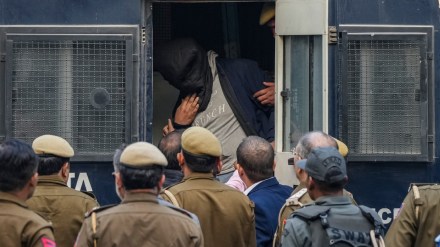Muzammil Ganaie, one of the main accused in the white-collar terror module case, has reportedly told the National Investigation Agency (NIA) how a fund of Rs 26 lakh was collected from five doctors to plan coordinated terror attacks in several cities. According to investigators, the group spent almost two years buying explosives and remote-triggering devices for the plot, according to a report by Hindustan Times.
Officers said Ganaie admitted he put in Rs 5 lakh, while Adeel Ahmad Rather and Muzaffar Ahmad Rather gave Rs 8 lakh and Rs 6 lakh respectively. Shaheen Shahid is said to have added Rs 5 lakh and Dr Umar Un-Nabi contributed Rs 2 lakh. All the money was then given to Umar, suggesting he had a key role in carrying out the plan.
Turning fertiliser into explosives
Ganaie also told investigators that he bought 26 quintals of NPK fertiliser from Gurugram and Nuh for around Rs 3 lakh.
“He was responsible for sourcing fertiliser and other chemicals. They were not building explosives overnight, it was being planned meticulously,” an NIA official told HT, requesting anonymity.
Investigators say the fertiliser was then turned into explosive material under Umar’s supervision. He also arranged remote detonators and electrical circuits. They added that ammonium nitrate and urea were also stockpiled.
“There was a clear division of responsibilities. Umar was handling the technical part,” the officer said.
So far, three doctors – Ganaie, Shahid and Adeel Rather – have been arrested. Adeel’s brother Muzaffar, also suspected to be involved, is believed to be in Afghanistan. Officials are also looking for Nissar ul-Hassan, who worked at Al-Falah Medical College with Umar, Ganaie and Shahid.
Investigators say Umar was driving a Hyundai i20 when he detonated a stockpile of explosives near the Red Fort on November 10, just escaping the police.
Confession helps link evidence
The confession has helped the investigating agency to connect earlier scattered clues, another NIA officer told the outlet. “The scale of recovered materials has reinforced suspicions of a plan to carry out serial blasts rather than a one-off strike. The quantity they amassed cannot be for a single explosion,” he said.
They also noted that a confession is only valid in court if it is given in front of a magistrate or a judge.
Officials are now trying to identify the suppliers of the material and check whether the group used their professional identities to support the operation. “It appears to be a deeply embedded network operating with academic cover. The aim now is to uncover every node,” the second officer said.
Umar Nabi tried to reunite Jaish module after ideological split
Because of growing disagreements over ideology, money and how to carry out an attack, Umar Nabi did not attend the wedding of Adeel Rather in early October. Investigators told The Indian Express that Umar had distanced himself from the rest of the Jaish-e-Mohammed module. But when cleric Mufti Irfan Wagay was detained in Kashmir, Umar hurried to Qazigund on October 18 to reconnect with the group and “keep them on track”.
Another major point of conflict within the group was Umar’s reluctance to explain how he was using the money.
Sources said that the arrested men – Muzammil Ganai, Adeel Rather and Wagay – often disagreed with Umar. While they were more influenced by Al Qaeda’s ideology, Umar leaned towards ISIS (Daesh).
Investigators also said Umar believed he was carrying forward the militant legacy of Burhan Wani and Zakir Moosa in Kashmir. They found that he had been studying how to make IEDs since 2023, the IE report mentioned.
